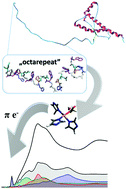Electronic properties of a PrPC–Cu(ii) complex as a marker of 5-fold Cu(ii) coordination†
Abstract
Human prion protein is a subject of extensive study, related in particular to the molecular basis of neurodegenerative disease development and prevention. This protein has two main domains: the membrane C-terminal, structured domain as well as the unstructured N-terminal domain. While PrPC (23–231) has up to eight Cu(II) binding sites in the N-terminal domain, it includes a characteristic, conservative octarepeat region PHGGGWGQ, which was studied by means of X-ray absorption near edge spectroscopy. The measurements were conducted at the SuperXAS beamline (SLS, PSI, Villigen). For the initial 1 : 1 protein-to-Cu(II) ratio, the two main Cu(II) binding modes were identified using linear combination fitting and ab initio FEFF calculations for X-ray spectra. Their electronic structures indicated that Cu(II) coordinated by strong π-donors could effectively suppress the pre-edge structure due to the filling of empty Cu(II) d-states. The suppression was correlated with the charge transfer effect and filling of the virtual electronic Cu(II) states. What is more, we showed that the 1s → 4p + LMCT (Ligand-to-Metal-Charge-Transfer) multielectron transition relation with the main edge transition could be used as a marker for preliminary comparison of an unknown organic compound to a reference. The presented results permitted a possible explanation of the mechanism of choosing the preferred Cu(II) modes in PrPC–Cu(II) coordination processes and of the complex stability from the electronic point of view.



 Please wait while we load your content...
Please wait while we load your content...